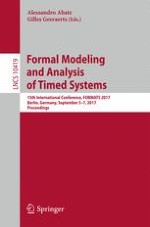2017 | Book
Formal Modeling and Analysis of Timed Systems
15th International Conference, FORMATS 2017, Berlin, Germany, September 5–7, 2017, Proceedings
Editors: Alessandro Abate, Gilles Geeraerts
Publisher: Springer International Publishing
Book Series : Lecture Notes in Computer Science
